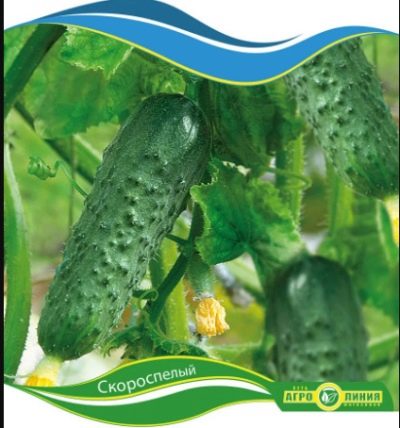
- Authors: Kudryavtseva E.R.
- Year of approval: 2015
- Growth type: indeterminate
- Branching: the average
- Fruit weight, g: 200-300
- Fruit color: dark green
- Ripening terms: mid-early
- Fruit shape: cylindrical
- Fruit taste: great
- Appointment: universal
Summer residents and farmers - lovers of medium early types of cucumbers, will certainly like the hybrid Mashenka, which is completely easy to grow, but it gives excellent yields. To enjoy delicious greens from the garden, it is enough to familiarize yourself with the characteristics of the vegetable, as well as the intricacies of its cultivation.
Breeding history
Cucumbers Mashenka is a novelty in the segment of vegetable crops, which in a short period of time has become in demand among gardeners and farmers. The hybrid was bred by Russian scientists in 2014, and a year later (in 2015) the species joined the ranks of the State Register of Breeding Achievements of the Russian Federation. The authorship belongs to the breeder E. R. Kudryavtseva. The plant can grow productively in any climatic zone of the country. Hybrid cucumbers are grown in open ground and under a film.
Description of the variety
The mid-early hybrid is a plant of an indeterminate type, characterized by moderate branching, medium thickening of emerald-green leaves, and a developed root system. In addition, a medium-sized bush has a moderate growth and the appearance of side shoots.
At the time of flowering, light yellow flowers of a predominantly female type are formed on the bushes. In each knot, 1-2 fruits are tied. It should be noted that the hybrid is parthenocarpic (not requiring auxiliary pollination by bees) with a bouquet arrangement of ovaries.
Characteristics of the appearance of plants and zelents
Zelentsy Mashenka are endowed with an excellent appearance. On a healthy cucumber bush, fruits ripening weighing 110-130, and sometimes even 200-300 grams, 9-11 cm long. Leveled cucumbers grow. The shape of the zelentsy is correct - cylindrical or oval-elongated. A ripe vegetable is evenly covered with a dark green color. The peel of the fruit is of medium density, glossy, covered with small tubercles and white thorns.
Harvesting should be on time, otherwise vegetables overexposed on the bushes will lose their taste and marketability. The harvested crop can be transported, since the zelents can easily transfer transportation over long distances without losing the marketability of vegetables. In addition, cucumbers are perfectly stored in a cool place without losing their taste and benefits.
Purpose and taste of fruits
Zelentov's taste is bright, memorable, which undoubtedly captivates many housewives. Cucumber pulp is characterized by a firm, fleshy, tender, crunchy and juicy structure without voids and wateriness. The taste is balanced - summer sweetness is complemented by a refreshing aroma that does not disappear even after heat treatment of vegetables. There is no bitterness in the pulp, and there are practically no seeds.
Fresh cucumbers Mashenka can be consumed collected from the garden, added to various salads and slices, canned, pickled, and also used in the preparation of pickles. In addition, this species provides for the collection of greens 5-7 cm long (gherkins).
Maturation
Masha belongs to the class of mid-early hybrid varieties. The growing season lasts 35-45 days (depending on the climatic characteristics of the planting region). The germination of sprouts in the culture is friendly. Zelens ripen gradually, so the fruiting period can last until the onset of cold weather. As a rule, the mass harvest takes place in July-August, however, you can choose cucumbers in September-October.
Yield
The yield of the hybrid is high. When caring for a vegetable crop, you can count on 10.5-15.3 kg of crispy greens per 1 m2 of plantings. In a greenhouse, the yield is slightly higher.
Landing scheme
When planting, it is important to observe the distance between the plantings, as well as the density, which will ensure sufficient access of light, heat, air and moisture to each cucumber bush. It is recommended to place 2-3 bushes per 1 m2. Optimal for planting can be considered a scheme of 70x30 cm.
Growing and care
The culture is grown mainly by the seedling method, which allows you to get tasty and healthy fruits early enough. In greenhouses, planting is carried out in May, and in garden beds - in late spring - early summer. It is not recommended to plant cucumber bushes in an area where pumpkin crops used to grow.
Soil requirements
The hybrid is undemanding to the structure of the soil, it is enough for it to be light, fluffy, fertile, allow moisture and air to pass through, and also have neutral acidity. The plant is not very productive if it is planted on swampy ground. The hybrid develops on sandy loam, chernozem and loamy soils.

In order to collect strong, tasty and beautiful cucumbers on your site, you need to make top dressing. Lack of nutrients can negatively affect the appearance of the plant and significantly reduce the yield. Fertilize cucumbers with organic fertilizers in combination with mineral fertilizers. With the right balance of these components and adherence to the fertilizing schedule, the cucumber yield will be maximum.
Required climatic conditions
Masha is a culture that loves warmth, light, moisture, therefore, the site for planting is sunny, protected from wind and drafts. In addition, the plant is susceptible to sudden drops in temperature and prolonged shade.
Disease and pest resistance
Due to its strong immunity, cucumber is resistant to many diseases - cucumber mosaic virus, powdery mildew, brown spot.

Despite their popularity, cucumbers are often attacked by diseases and pests. From them, cucumber plantings often die before the start of fruiting. In order to prevent this from happening, it is necessary to try to prevent ailments or get rid of them at the very beginning, having studied in detail their causes of occurrence, signs and methods of treatment.





























































































